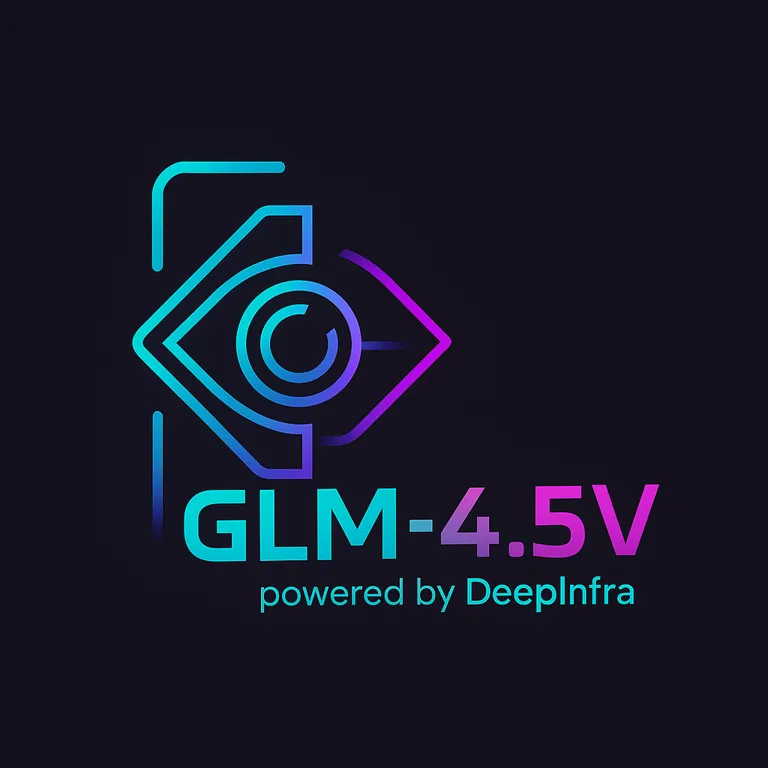
zai-org/GLM-4.5V
GLM-4.5V is based on ZhipuAI’s next-generation flagship text foundation model GLM-4.5-Air (106B parameters, 12B active). It continues the technical approach of GLM-4.1V-Thinking, achieving SOTA performance among models of the same scale on 42 public vision-language benchmarks. It covers common tasks such as image, video, and document understanding, as well as GUI agent operations.
GLM-4.5V is based on ZhipuAI’s next-generation flagship text foundation model GLM-4.5-Air (106B parameters, 12B active). It continues the technical approach of GLM-4.1V-Thinking, achieving SOTA performance among models of the same scale on 42 public vision-language benchmarks. It covers common tasks such as image, video, and document understanding, as well as GUI agent operations.

GLM-4.5V
Ask me anything
GLM-4.5V
👋 Join our Discord communities.
📖 Check out the paper.
📍 Access the GLM-V series models via API on the ZhipuAI Open Platform.
Introduction
Vision-language models (VLMs) have become a key cornerstone of intelligent systems. As real-world AI tasks grow increasingly complex, VLMs urgently need to enhance reasoning capabilities beyond basic multimodal perception — improving accuracy, comprehensiveness, and intelligence — to enable complex problem solving, long-context understanding, and multimodal agents.
Through our open-source work, we aim to explore the technological frontier together with the community while empowering more developers to create exciting and innovative applications.
GLM-4.5V is based on ZhipuAI’s next-generation flagship text foundation model GLM-4.5-Air (106B parameters, 12B active). It continues the technical approach of GLM-4.1V-Thinking, achieving SOTA performance among models of the same scale on 42 public vision-language benchmarks. It covers common tasks such as image, video, and document understanding, as well as GUI agent operations.

Beyond benchmark performance, GLM-4.5V focuses on real-world usability. Through efficient hybrid training, it can handle diverse types of visual content, enabling full-spectrum vision reasoning, including:
- Image reasoning (scene understanding, complex multi-image analysis, spatial recognition)
- Video understanding (long video segmentation and event recognition)
- GUI tasks (screen reading, icon recognition, desktop operation assistance)
- Complex chart & long document parsing (research report analysis, information extraction)
- Grounding (precise visual element localization)
The model also introduces a Thinking Mode switch, allowing users to balance between quick responses and deep reasoning. This switch works the same as in the GLM-4.5 language model.
Quick Start
Using with transformers:
pip install transformers-v4.55.0-GLM-4.5V-preview
and then run:
from transformers import AutoProcessor, Glm4vMoeForConditionalGeneration
import torch
MODEL_PATH = "zai-org/GLM-4.5V"
messages = [
{
"role": "user",
"content": [
{
"type": "image",
"url": "https://upload.wikimedia.org/wikipedia/commons/f/fa/Grayscale_8bits_palette_sample_image.png"
},
{
"type": "text",
"text": "describe this image"
}
],
}
]
processor = AutoProcessor.from_pretrained(MODEL_PATH)
model = Glm4vMoeForConditionalGeneration.from_pretrained(
pretrained_model_name_or_path=MODEL_PATH,
torch_dtype="auto",
device_map="auto",
)
inputs = processor.apply_chat_template(
messages,
tokenize=True,
add_generation_prompt=True,
return_dict=True,
return_tensors="pt"
).to(model.device)
inputs.pop("token_type_ids", None)
generated_ids = model.generate(**inputs, max_new_tokens=8192)
output_text = processor.decode(generated_ids[0][inputs["input_ids"].shape[1]:], skip_special_tokens=False)
print(output_text)
The special tokens <|begin_of_box|> and <|end_of_box|> in the response mark the answer’s bounding box in the image. The bounding box is given as four numbers — for example [x1, y1, x2, y2], where (x1, y1) is the top-left corner and (x2, y2)` is the bottom-right corner. The bracket style may vary ([], [[]], (), <>, etc.), but the meaning is the same: it encloses the coordinates of the box. These coordinates are relative values between 0 and 1000, normalized to the image size.
For more code information, please visit our GitHub.
Citation
If you use this model, please cite the following paper:
@misc{glmvteam2025glm41vthinkingversatilemultimodalreasoning,
title={GLM-4.1V-Thinking: Towards Versatile Multimodal Reasoning with Scalable Reinforcement Learning},
author={GLM-V Team and Wenyi Hong and Wenmeng Yu and Xiaotao Gu and Guo Wang and Guobing Gan and Haomiao Tang and Jiale Cheng and Ji Qi and Junhui Ji and Lihang Pan and Shuaiqi Duan and Weihan Wang and Yan Wang and Yean Cheng and Zehai He and Zhe Su and Zhen Yang and Ziyang Pan and Aohan Zeng and Baoxu Wang and Boyan Shi and Changyu Pang and Chenhui Zhang and Da Yin and Fan Yang and Guoqing Chen and Jiazheng Xu and Jiali Chen and Jing Chen and Jinhao Chen and Jinghao Lin and Jinjiang Wang and Junjie Chen and Leqi Lei and Letian Gong and Leyi Pan and Mingzhi Zhang and Qinkai Zheng and Sheng Yang and Shi Zhong and Shiyu Huang and Shuyuan Zhao and Siyan Xue and Shangqin Tu and Shengbiao Meng and Tianshu Zhang and Tianwei Luo and Tianxiang Hao and Wenkai Li and Wei Jia and Xin Lyu and Xuancheng Huang and Yanling Wang and Yadong Xue and Yanfeng Wang and Yifan An and Yifan Du and Yiming Shi and Yiheng Huang and Yilin Niu and Yuan Wang and Yuanchang Yue and Yuchen Li and Yutao Zhang and Yuxuan Zhang and Zhanxiao Du and Zhenyu Hou and Zhao Xue and Zhengxiao Du and Zihan Wang and Peng Zhang and Debing Liu and Bin Xu and Juanzi Li and Minlie Huang and Yuxiao Dong and Jie Tang},
year={2025},
eprint={2507.01006},
archivePrefix={arXiv},
primaryClass={cs.CV},
url={https://arxiv.org/abs/2507.01006},
}
Unlock the most affordable AI hosting
Run models at scale with our fully managed GPU infrastructure, delivering enterprise-grade uptime at the industry's best rates.


